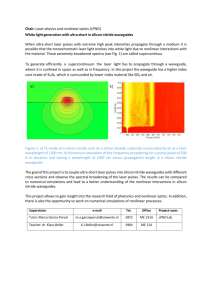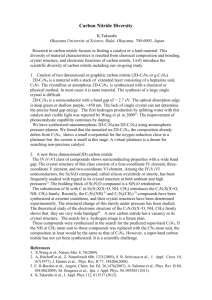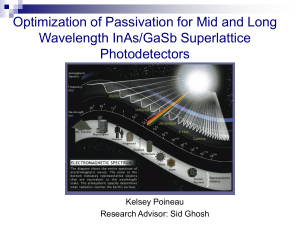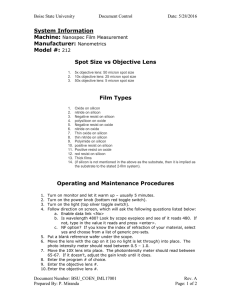Transparent amorphous silicon channel waveguides with silicon nitride intercladding layer Please share
advertisement
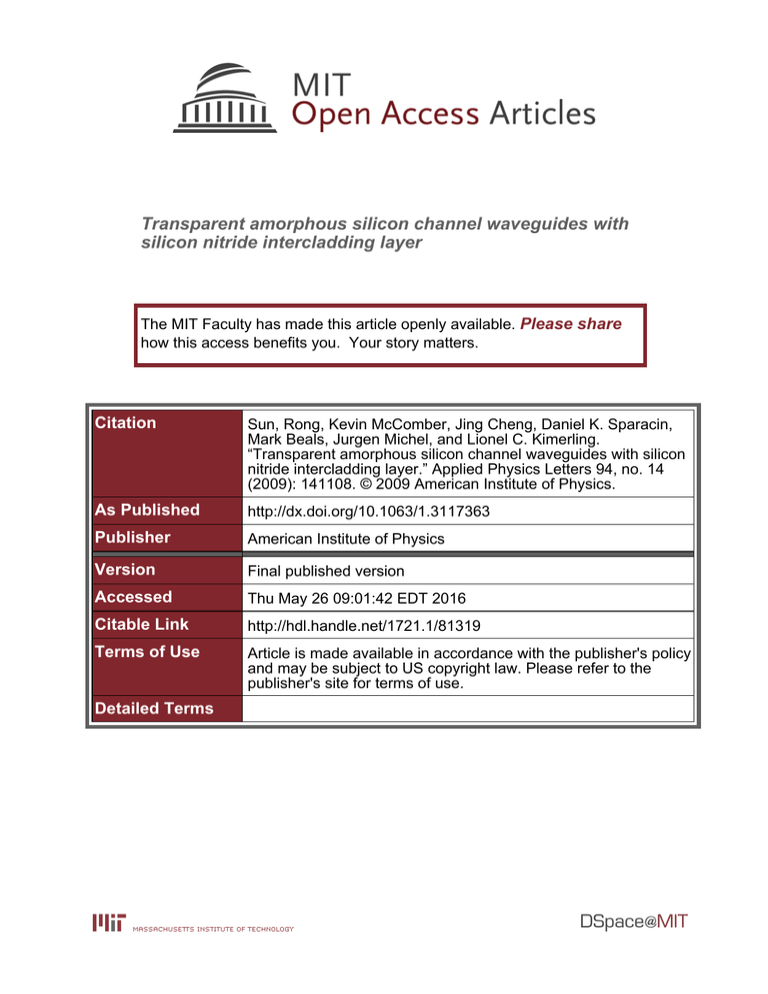
Transparent amorphous silicon channel waveguides with silicon nitride intercladding layer The MIT Faculty has made this article openly available. Please share how this access benefits you. Your story matters. Citation Sun, Rong, Kevin McComber, Jing Cheng, Daniel K. Sparacin, Mark Beals, Jurgen Michel, and Lionel C. Kimerling. “Transparent amorphous silicon channel waveguides with silicon nitride intercladding layer.” Applied Physics Letters 94, no. 14 (2009): 141108. © 2009 American Institute of Physics. As Published http://dx.doi.org/10.1063/1.3117363 Publisher American Institute of Physics Version Final published version Accessed Thu May 26 09:01:42 EDT 2016 Citable Link http://hdl.handle.net/1721.1/81319 Terms of Use Article is made available in accordance with the publisher's policy and may be subject to US copyright law. Please refer to the publisher's site for terms of use. Detailed Terms Transparent amorphous silicon channel waveguides with silicon nitride intercladding layer Rong Sun, Kevin McComber, Jing Cheng, Daniel K. Sparacin, Mark Beals et al. Citation: Appl. Phys. Lett. 94, 141108 (2009); doi: 10.1063/1.3117363 View online: http://dx.doi.org/10.1063/1.3117363 View Table of Contents: http://apl.aip.org/resource/1/APPLAB/v94/i14 Published by the AIP Publishing LLC. Additional information on Appl. Phys. Lett. Journal Homepage: http://apl.aip.org/ Journal Information: http://apl.aip.org/about/about_the_journal Top downloads: http://apl.aip.org/features/most_downloaded Information for Authors: http://apl.aip.org/authors Downloaded 24 Jul 2013 to 18.51.3.76. This article is copyrighted as indicated in the abstract. Reuse of AIP content is subject to the terms at: http://apl.aip.org/about/rights_and_permissions APPLIED PHYSICS LETTERS 94, 141108 共2009兲 Transparent amorphous silicon channel waveguides with silicon nitride intercladding layer Rong Sun,a兲 Kevin McComber, Jing Cheng, Daniel K. Sparacin, Mark Beals, Jurgen Michel, and Lionel C. Kimerling Department of Materials Science and Engineering, Microphotonic Center, Massachusetts Institute of Technology, Cambridge, Massachusetts 02139, USA 共Received 26 November 2008; accepted 23 March 2009; published online 9 April 2009兲 We have experimentally demonstrated single mode amorphous silicon channel waveguides with low optical transmission loss of 2.7⫾ 0.4 dB/ cm for TE mode in the 1550 nm range. This result was achieved by using hydrogen passivation of a-Si dangling bonds and a thin, low loss silicon nitride intercladding layer prepared by plasma enhanced chemical vapor deposition between the waveguide core and the oxide cladding layer. The silicon nitride intercladding layer reduces waveguide sidewall roughness scattering and preserves the hydrogen passivation. © 2009 American Institute of Physics. 关DOI: 10.1063/1.3117363兴 Amorphous silicon 共a-Si兲 is attractive as an alternative optical waveguide material to single crystalline silicon for its high refractive index and capability of low cost deposition on SiO2. Hydrogen passivation improves a-Si’s transparency by reducing dangling bond absorption in a-Si. However, in order to integrate a-Si optical waveguides at interconnection level, hydrogen passivation is often lost due to hydrogen evolution at 450 ° C. A thin silicon nitride intercladding layer deposited using plasma enhanced chemical vapor deposition 共PECVD兲 method is designed to preserve the H passivation, thus improving optical transparency in a-Si waveguide core.1 An additional complication is that PECVD silicon nitride introduces extra optical loss due to N–H bond resonance absorption. As a result, the overall a-Si channel waveguide transmission loss coefficient ␣ consists of the a-Si bulk absorption loss coefficient ␣a-Si, sidewall roughness scattering loss coefficient ␣sidewall, and bulk absorption loss coefficient of the cladding layers, e.g., the silicon nitride ␣nitride, as expressed as = 1.90– 2.09兲 reduces a-Si sidewall refractive index contrast, reducing the sidewall roughness scattering loss coefficient ␣sidewall.2 It also works as a hydrogen diffusion barrier to preserve hydrogen passivation. As-deposited PECVD silicon nitride contains nitrogenhydrogen 共N–H兲 bonds whose resonance absorption is centered at 1510 nm.1,3,4 Development of processes that can minimize N–H concentration in PECVD silicon nitride is the key to achieving low loss optical transmission in a-Si waveguides in the 1550 nm region. Such process must be compliant with low loss, hydrogenated a-Si process thermal budget of less than 450 ° C to prevent high optical loss due to crystallization of a-Si 共⬎650 ° C兲 and H out-diffusion 共450– 650 ° C兲.5 We used an in situ nitrogen/argon 共N2 / Ar兲 plasma treatment process to reduce H in the as-deposited nitride film at 300 ° C. Experimental details for H reduction ␣ = ⌫a-Si␣a-Si + ␣sidewall + ⌫nitride␣nitride + 共1 − ⌫a-Si − ⌫nitride兲␣oxide , where ⌫a-Si, ⌫nitride, and 共1 − ⌫a-Si − ⌫nitride兲 are the confinement factors in a-Si waveguide core, in silicon nitride intercladding layer, and in oxide cladding, respectively; ␣oxide is the bulk absorption loss coefficient of the oxide cladding which is negligible. Minimizing ␣a-Si, ␣sidewall, and ␣nitride is the key to improving the total transparency of the a-Si waveguide. In this paper, we demonstrate low optical transmission loss of 2.7⫾ 0.4 dB/ cm for TE mode in single mode, a-Si channel waveguide devices with 10 nm low loss silicon nitride intercladding layer at 1560 nm, comparable to single crystalline silicon counterparts. Figures 1共a兲 and 1共b兲 shows the waveguide configuration and index profile with the incorporation of a PECVD silicon nitride intercladding layer between the a-Si waveguide core and the PECVD SiO2 共n = 1.46兲 cladding. This thin nitride layer 共e.g., n a兲 Author to whom correspondence should be addressed. Electronic mail: rsun@mit.edu. 0003-6951/2009/94共14兲/141108/3/$25.00 FIG. 1. 共Color online兲 共a兲 Schematic of the waveguide cross section and 共b兲 waveguide index profile. 94, 141108-1 © 2009 American Institute of Physics Downloaded 24 Jul 2013 to 18.51.3.76. This article is copyrighted as indicated in the abstract. Reuse of AIP content is subject to the terms at: http://apl.aip.org/about/rights_and_permissions 141108-2 Appl. Phys. Lett. 94, 141108 共2009兲 Sun et al. FIG. 2. 共Color online兲 共a兲 Schematic of the racetrack resonator and 共b兲 a SEM image of the coupling region. in PECVD silicon nitride using plasma treatment can be found elsewhere.6 In our optimal process, 80% NH bonds is removed from the as-deposited thin film. The resulting refractive index is 1.90. The nitride plasma treatment can be seamlessly integrated with the waveguide fabrication process flow. On 1 m thermal SiO2 under cladding layer the device cross section is 700 nm共width兲 ⫻ 100 nm共height兲 waveguide core fabricated by direct reactive ion etch of a-Si. To study the effect of the different silicon nitride intercladding layers, the wafer was broken into quarter-size pieces and the following samples were obtained: 共1兲 Sample 1: Control, with no nitride intercladding layer. 共2兲 Sample 2: Deposited with 10 nm as-deposited nitride intercladding layer 共n = 2.10兲. 共3兲 Sample 3: Deposited with 10 nm plasma-treated nitride intercladding layer 共n = 1.90兲. In the final step, all samples were cladded with 1 m PECVD SiO2 as the top cladding layers. Waveguides transmission losses can be derived accurately from the resonance spectrum of a first order resonator.7 The racetrack resonator design helps enhance the optical coupling for large coupling gaps of 600 nm. The coupling distance is 100 m. The bend radius is 50 m at which radiation loss due to bending is negligible. The resulting round trip loss of the resonator is solely the waveguide transmission loss. Figure 2 shows the schematics of the device configuration and a scanning electron microscopy 共SEM兲 image of the coupling region. We obtain the resonator spectrum for TE mode only because with a 1 m thick under cladding layer the TM mode is intentionally lost due to substrate leakage. Figure 3 highlights the resonance spectra and their Lorentzian fits of the devices from Samples 1–3, respectively. The resonance wavelength 共R兲, extinction ratios 共re兲, FIG. 3. 共Color online兲 关共a兲–共c兲兴 Resonance spectra over the same 0.6 nm range for process 1–3, respectively. The black lines are the corresponding Lorentzian fits. The large periodic ripples are the Fabry–Pérot resonances from the waveguide input and output facets. and quality factors 共Q兲 are obtained from their Lorentzian fits, summarized in Table I. Incorporation of a 10 nm asdeposited nitride intercladding layer around the a-Si channel waveguide core reduced the waveguide transmission loss coefficient from 12.0⫾ 1.8 dB/ cm to 6.5⫾ 0.9 dB/ cm. These TABLE I. Summary of the resonance wavelength R, extinction ratio re, quality factor Q, and transmission loss coefficients ␣ for samples with processes 1–3, respectively. Sample ID R 共nm兲 re 共dB兲 Q ␣ 共dB/cm兲 1 2 3 1558.146 1559.587 1560.319 12.3 5.4 6.9 22 500 60 400 141 800 12.0⫾ 1.8 6.5⫾ 0.9 2.7⫾ 0.4 Downloaded 24 Jul 2013 to 18.51.3.76. This article is copyrighted as indicated in the abstract. Reuse of AIP content is subject to the terms at: http://apl.aip.org/about/rights_and_permissions 141108-3 Appl. Phys. Lett. 94, 141108 共2009兲 Sun et al. results are in good agreement with previous reports in Ref. 1 where the loss values are derived from straight waveguides using the “cut-back” method. The plasma-treated nitride film further reduced the a-Si waveguide core transmission loss to 2.7⫾ 0.4 dB/ cm. The 3.8 dB/cm loss reduction results from removal of 80% of NH bonds from the as-deposited PECVD nitride film. In conclusion, we have demonstrated a minimal transmission loss of 2.7⫾ 0.4 dB/ cm for TE mode at 1560 nm in single mode, a-Si channel waveguides, comparable to single crystalline silicon channel waveguides. Our approach consists of using a well-passivated a-Si waveguide core and a low loss PECVD silicon nitride intercladding layer. We discovered that removal of 80% of NH bonds in nitride film results in 3.8 dB/cm transmission loss coefficient reduction in a-Si channel waveguides. This nitride layer also preserves H passivation and potentially allows a-Si waveguide to maintain its low loss property at temperatures higher than 400 ° C. 1 D. K. Sparacin, R. Sun, A. Agarwal, M. Beals, J. Michel, T. Conway, A. Pomerene, D. Carothers, M. Grove, D. M. Gill, M. S. Rasras, S. S. Patel, A. E. White, and L. C. Kimerling, Proceedings of Third IEEE International Conference on Group IV Photonics, 2006, pp. 255–257. 2 T. Barwicz and H. A. Haus, J. Lightwave Technol. 23, 2719 共2005兲. 3 F. Ay and A. Aydinli, Opt. Mater. 26, 33 共2004兲. 4 G.-L. Bona, R. Germann, and B. J. Offrein, IBM J. Res. Dev. 47, 239 共2003兲. 5 P. K. Lim, W. K. Tam, L. F. Yeung, and F. M. Lam, J. Phys.: Conf. Ser. 61, 708 共2007兲. 6 M. Balseanu, L.-Q. Xia, V. Zubkov, M. Le, J. Lee, and H. M’Saad, Meet. Abstr. Electrochem. Soc. 502, 532 共2006兲. 7 A. Yariv, Electron. Lett. 36, 321 共2000兲. Downloaded 24 Jul 2013 to 18.51.3.76. This article is copyrighted as indicated in the abstract. Reuse of AIP content is subject to the terms at: http://apl.aip.org/about/rights_and_permissions
